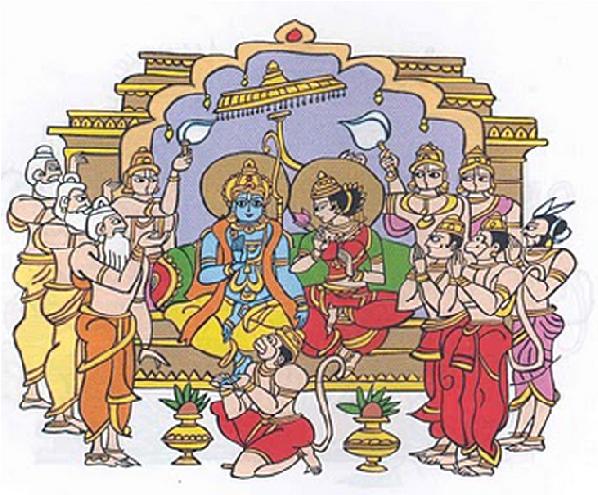Dear Bhakthas of Raghu Veera:
Let us commence these postings with the two tributes of Sage Valmiki to the supreme ruler(Chakravarthi) Ramachandra. They are:
Tamevam guNasampannam apradhrushya parAkramam |
lokapaalOpamam nAtham akAmayatha medhinee ||
(Meaning): Earth seeks to have as its master, the aforesaid Rama of Unfailing might, and vying with the guardians of the quarters, endowed as he is with the above-mentioned virtues.
aanrusamsyamanukrosa: srutham seelam damassama: |
Raghavam sobhayatyEtE shaDguNA: purushotthamam ||
(Meaning): Six GuNAs adorn Sri RamachandrA: Protection of those who seek refuge at His holy feet, Compassion, Knowledge of the inner meanings of the VedAs, the uninterrupted and ease of union even with those who are no match to Him (Sowlabhyam), control of mind and the control of the Karma and JnAna IndriyAs.
Such a celebrated emperor was RamA, who ruled the Earth after His return to AyodhyA following his victory over the evil RavaNA.
GS 77: Haataka giri kataka laDaha paada peeta nikata Thata parilutitha nikhila nrupathi kireeta kOti vividha maNi gaNa kiraNa nikara neerajitha charaNa rajeeva! Jaya! jaya!
(meaning): Hail to Thee, O Raghuveera with the Lotus feet, which have been illuminated by the Neerajanam (Aaratthi) of the beams of resplendent rays emanating out of the gems adorning the edges of the crowns of all the kings prostrating themselves at the foot of your throne (SimhAsanam), which is as broad as the foot hills of mount Meru! Hail to Thee!

Sri Rama is sitting on His imperial throne with His dEvi in the darbhAr at the time of His coronation. The vassals of the empire have assembled in front of Sri Pattabhi RaamA’s throne and are offering their ShAshtAnga namaskArams. The foot of the throne is broad like the foot hills of the lofty Meru-mountain like simhAsanam. The kings are wearing gem-studded crowns during this time of their prostrations before their supreme Lord. The rays of light emanating from the mangaLa deepams illuminating the DarbhAr reflect the lustre of the gems adorning their crowned heads as they lower their limbs on ground and lift themselves up. Those reflections arising from the interaction of the light beams and the gems of the crowns appear like a mangaLa aarathi raised in front of their newly crowned emperor, Sri RamachandrA.
The occasion of performance of NeerAjanam (Aaratthi) is an auspicious one to celebrate the supremacy of the Lord during His aarAdhanam. Saint Thyagaraja saw this splendid sight of the darbhAr of SitAraman during the pattabhishekam at AyodhyA with his mental eyes at his pujA graham and joined with the assembled kings to conduct Aaratthi to the AkhilAdakoti NAyakan in one of his Surutti Krithis:
Pallavi: Pathiki haarateerE SitA (pathiki)
Anupallavi: Athi mrudhutara satva bhashaNanuki
akhilAndha Naathuniki SitA (Pathiki haarateerE)
CharaNam 1: bhangaruranghuku bhujanguni pyni chelanguchunu maragathAngudu meruputheraDguna merayu tana yanganathO palukanga jUji yupponguju SitA (Pathiki haarateerE)
CharaNam 3: raja vibhAkara raja dharAmara raja suAja virAjulu chooDaka rajamAnamagu gAjulu gallanaraajitha Thyagaraaja nuthuniki Sri (SitA PathikihArateerE)
Saint ThyagarajA sitting at his pujA graham on the banks of Cauveri enjoys the splendor of this sight and is worried whether any drishti dhosham will arise and hence he invites all the sumangali’s assembled in front of Sri SitApathi to offer Neerajanam to the Rajaathiraajan. He himself joins them in this sacred rite. He says: “Let us offer NeerAjanam (Haaratthi) to our Lord, the Lord of the Universe, of sweet and mellowed speech, when He is seated on the golden-hued Sesha (Sesha SimhAsanam), conversing with His consort SitA Devi of radiant beauty. Standing on either side (of the throne), let the(assembled) ladies with charming faces and shining ornaments offer the haratthi to the delight of DevAs and Rishis.”
Sri RamachandrA’s position as the supreme ruler of the Universe is celebrated here with great bhAvam by the bard of ThiruvaiyAru in this Surutti Raaga krithi.
GS 78: divya BhowmAyOdhyAdhi Daivatha! Jaya! Jaya!
(Meaning): Hail to Thee, O Ubhaya Vibhuthi NaathA! You rule both the AyOdhyAs — one invincible (AyOdhya) known as Sri VaikunTam and the other one in Kosala Desam on this earth — with equal ease and display Your suzerainty.
Here Swami Desikan celebrates the Mukundha aspect of Sri RamachandrAin the spirit of Mukunda MAla sthotram. King KulasekharA chose the word Mukundha for Sri Kaakuthsa –RanganAthA for the combinatuion of the three Aksharams, Mu, Ku and dha. Mu stands for Mukthi and Sri VaikunTanaathanin invincible Ayodhya (Sri VaikunTam) known as Parampadham. That is Nitya Vibhoothi. The aksharA “ku” stands for the invincible capital of SriRama known as AyOdhyA on this Bhumi, which stands for the LeelA Vibhoothi. The literal meaning of AyOdhyA is that which is invincible to enemies.Thus both the AyOdhyAs –the Nitya and LeelA vibhoothis – are under the Lordship of the emperor of emperors, Sri RamachandrA. Thus He is celebrated and eulogized as Ubhaya Vibhoothi nAthan by Swami Desikan through this salutation.
Lokavatthu leelA kaivalyam…. Brahma Sutram 2.1.33
Oppiliappan Koil VaradAchAri Sadagopan
To be continued…








